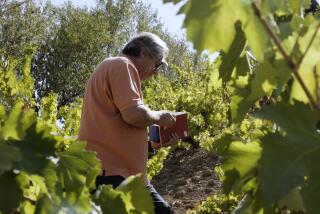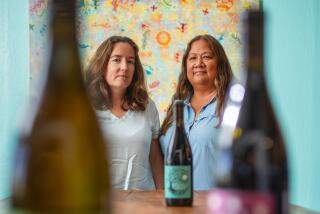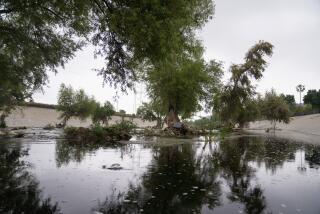Paddling a Canoe Under Vineyards on the Mosel
- Share via
TRIER, West Germany — A white swan watched as we pumped up our inflatable canoe beside the Mosel River.
It was 9 a.m. on a recent Saturday in this city founded by the Romans more than 2,000 years ago. The nearest navigation marker on the river bank is numbered 191, which meant that my wife and I could look forward to paddling 191 kilometers, about 122 miles, beneath vineyards and past ancient wine villages to reach Koblenz, where the Mosel flows into the Rhine.
It was an adventure we had been daydreaming about for three years--ever since the springtime when we had traveled this route slowly on the Mosel Wine Road in a rental car.
We knew from canoeing other rivers of the world that a day of slow driving and sightseeing could mean nine or 10 days of paddling our canoe and towing the small dinghy that carries our luggage.
At such a pace, the vineyard panoramas and millenniums of history could be experienced as in no other way of travel.
Upstream on Cruise Ship
Coming to the Mosel this time, we had checked the canoe and dinghy with our other baggage aboard the Lufthansa flight from Los Angeles to Frankfurt. After traveling around Germany and finally reaching Koblenz by rental car, we then relaxed in the luxury and leisure of cruising the Mosel upstream to Trier aboard the KD German Rhine Line cruise ship Europa, spending three days on the river and two overnights aboard while docked in wine villages.
This had given us fascinating perspectives on the scenic beauty and history of the river as we charted our canoeing course, making notes about the river itself, the waterfront inns and possible landing places in each wine village. For those who can’t bring their own boat to the Mosel or rent one here, a combination of the KD cruise in one direction and the wine road by rental car in the other could also be a rewarding travel experience.
It’s always difficult to leave Trier by any mode of transportation. We were here three years ago, when this city of 100,000 was celebrating the 2,000th birthday of its founding by the Caesars as a colonial capital of the Roman Empire. On this visit we spent much of two days walking along streets from the river banks to and around Porta Nigra, the largest city gate ever built by the Romans.
Storybook Villages
The swans stayed close behind the dinghy until we paddled slowly with our double-bladed paddles under the last of Trier’s bridges and turned to wave farewell to them and the city.
Scarcely four kilometers from our departure ramp we were between two storybook villages. Near the shore of Pfalzel on the left bank we drifted close to the remains of a palace once occupied by Frankish kings and the Roman governors.
Letting the slow current carry us along, I dipped the tip of my paddle to steer from the rear of the canoe while Elfriede, my wife, rested against the inflated back of her seat, which I braced with my bare feet. She read aloud the story of Pfalzel in our illustrated river map, pointing out a 7th-Century parish church and a beckoning wine pub that may be even older.
We also carried with us a copy of the classic, “Small Boat on the Moselle,” written by English author Roger Pilkington and published in 1968. His small boat was a 45-foot diesel cruiser, large compared to our canoe but small in relation to the barges and cruise ships sharing the waterway.
We navigated a widening of the river zoned for water skiers. The wind surfers stayed clear of them. Weekenders were out in their powerboats. Sightseeing cruise ships passed us. Barges with the skipper’s family living aboard moved downstream toward the Rhine or upriver toward Luxembourg and France.
We exchanged waves with everyone. On previous canoe trips along European rivers we had learned to cope with the waves created by barges, cruise ships and powerboats by quartering into them to avoid being swamped or rolled over.
The river began to wind in curves, often nearly forming a circle. Vineyards and forests soar above both banks, on hills often topped with ruins of ramparts and castles. On the left bank a baroque palace rose out of the wine village of Quint, where a rivulet flows into the Mosel.
Fishermen on the banks greeted us. Children came racing from riverfront campgrounds for a closer look at our canoe and dinghy. The heat of the summer day settled in and we began wistfully hoping for a cool breeze around the next curve.
At the Longuich-Kirsch river bend, the wine village church of St. Laurentius presented a smiling Madonna of the 16th Century. She held a bunch of grapes, a reminder that we would soon be ready to sip and dine.
Little Boat, Big Lock
We had been paddling about seven hours when we reached the lock at Detzem, one of the system of 10 locks that grew out of a post-World War II cooperative effort put together by Charles de Gaulle of France and Konrad Adenauer of West Germany.
The locks opened the modern era of shipping and pleasure-boating on a river the Romans had been able to navigate in only two ways: downstream by steering and rowing, upstream by bargemen trudging along the shore with lines taut over their shoulders.
Detzem was the only lock we encountered that didn’t have a smaller passageway for sports boats. We paddled cautiously behind a barge into the main lock, as we had learned to do on the rivers of France, staying as far back as possible from the stern propellers. As the water level dropped more than 20 feet, we maintained control of canoe and dinghy by holding onto rungs of a steel ladder embedded in the concrete.
When it was time to exit the lock, we couldn’t paddle hard enough to achieve any forward momentum against the propeller wash until the barge had moved some distance ahead. Then we could get out of the lock to pamper ourselves by hitchhiking a ride on the sudden rush of current created by water pouring over the dam.
Anchoring at the Inn
Soon we saw a church steeple and then Hotel Zum Anker, a charming wine inn on the riverfront. Like other villages along the Mosel, Detzem has its own Zum Anker. They are independent inns, usually with the symbol of an anker (anchor) between the balconies.
It was 5 p.m. and we were at the 166-kilometer navigation mark. We carried our canoe and dinghy into the garage behind the inn. After cooling ourselves with a shower and large steins of beer, we were ready for dinner and a chance to sample a local wine.
So ended our first day of paddling. Each of the next eight days would add new lyrics to canoeing a river which poets since Roman times have called “fairest of all.”
All but one day was sunny. The rainy day drenched us despite our parkas, and at times we couldn’t paddle hard enough against the wind to keep from drifting upstream. But around the next curve the wind would be with us, and the day added a special mellowness to our choice of wine for dinner.
We would need to write a sequel to Pilkington’s book to share all of our experiences. On our second day of paddling we landed at Neumagen, the oldest German wine village. That day we also came upon the world-famous wines of Trittenheim and the story of Johannes von der Heiden, the son of a local vintner who became one of the great scholars of the 15th Century.
Paddling out of Neumagen we soon reached Piesport wine village, whose labels such as Piesporter Goldtroepfchen are among the best known of all Mosel wines. The ceiling and fresco paintings in the parish church of St. Michael are treasures of art.
We shared the day with other paddlers. Half a dozen English teen-agers passed by in kayaks, following the commands of their instructor. A van carried their camping gear and six other student kayakers.
The two groups changed places each day between van and kayaks, and we met often. A middle-aged man from the Grand Duchy of Luxembourg, paddling alone toward the Rhine in a rental kayak large enough for his gear, drifted beside us several times for the next few days as we exchanged thoughts about the river.
Happiest of our encounters were the three times we met the Europa coming up or down the river on its cruise schedule. Capt. Werner Proff sounded the ship’s horn and came out on the bridge to wave. On another afternoon, the Europa docked at Bernkastel-Kues, about an hour ahead of us. A rowboat, with Capt. Proff at the oars, came out to guide us to the best landing place.
Bernkastel-Kues is the wine center of the middle Mosel. The hyphenated village is on each side of the river, beneath the ruins of Landshut Castle, built in AD 1277. Like all castles and fortifications along the Mosel, it could tell stories of invasions over the centuries, spanning the 30 Years’ War and the forays of the French Imperial armies.
On the Kues side we visited one of the most interesting wine museums of Europe. We learned that in spite of the vastness of vineyards on the hillsides above both banks of the Mosel between Trier and Koblenz, most are small family enterprises. Bernkastler Doktor, on the other hand, is a white wine we have enjoyed in Southern California.
Our paddling journey ended in Koblenz, where the Ehrenbreitstein Castle rises majesticly above the confluence of the Mosel and the Rhine.
For budgeting and planning your own Mosel journey, you can expect to find comfortable double accommodations in the wine villages for about $35. For questions about transporting your own own inflatable canoe, as we did, check with the Lufthansa office in Los Angeles at (213) 680-0700.
For assistance in renting a canoe or small boat in Trier, contact Guenter Jacoby, Tourism Director, Trier Tourist Office, An der Porta Nigra, 5500 Trier, Federal Republic of Germany. Check with your travel agent for details on cruising the Mosel with KD German Rhine Line. Three-day cruises start at about $320 per person, double occupancy.
More to Read
Sign up for The Wild
We’ll help you find the best places to hike, bike and run, as well as the perfect silent spots for meditation and yoga.
You may occasionally receive promotional content from the Los Angeles Times.






